People across the world were shocked to see a drug gang waving rifles and grenades in the TC Television studios in Guayaquil, and the scene was perhaps the cinematic peak of successive days of explosions, riots, lootings, shootings, car explosions, and widespread panic that has paralyzed the country.
However, the shocking and unprecedented episode on the public channel in Guayaquil—and the events that preceded and followed it—are just the latest chapter in a spiral of organized violence that has lasted for about five years and that has metastasized in the last two. It is the sad metamorphosis of a country that went from being the second safest in Latin America to becoming the most violent, with a homicide rate that has grown almost 800% since 2019.
The current powder keg
The catalyst of the past several days was the prison escape of two drug lords in the midst of riots and kidnappings of police officers in half a dozen prisons. The prison crisis is the most visible face of the hecatomb: the constant massacres, generally due to confrontation between gangs, have left more than 460 prisoners dead since 2021.
Read more: No end in sight for Ecuador’s prison crisis
The young president Daniel Noboa, who took office a month and a half ago to complete Guillermo Lasso’s term, responded by declaring a state of emergency and a curfew, which ended up causing a flurry of armed attacks and assassination attempts throughout the country that included the viral takeover of the channel.
Faced with the widespread chaos, and after receiving support from the entire political spectrum – including the exiled former president Rafael Correa –, Noboa issued a new decree that recognizes the state of “internal armed conflict” and orders the military forces to neutralize 22 organizations which it declares as “terrorist groups.” The debut day of this total war on the gangs left at least 13 dead and 41 arrested.
The country went into shock: in-person classes were suspended, most businesses closed, and the population barricaded themselves in their homes. War tanks roam the empty streets while sources of violence and clashes multiply, predicting a bloody uncertain outcome.
Five basic points
The following are some keys that try to unravel how this model of daily violence and death governed by narco-criminal gangs was established:
1-The international factor. Ecuador is located in the middle of Colombia and Peru, the world’s largest producers of cocaine. The presence of the FARC in southern Colombia functioned as a kind of blockade for the expansion of the cartels towards Ecuador, but the signing of the peace agreement in 2016, and the subsequent demobilization of the guerrilla, deconfigured that border territory and opened the floodgate to the criminal economy to establish its operations, mainly in the ports of Guayaquil and Esmeraldas.
Furthermore, within the framework of a reconfiguration of drug routes, Ecuador became a large regional center for the storage, processing and distribution of drugs destined mainly for the United States and Europe. In a short time, more than twenty gangs proliferated, operating in a fragmented manner, in many cases as subcontractors of the large cartels of Mexico and Colombia.
2- The dismantling of the State. The above is linked to the shift in the economic model implemented with the betrayal of Lenín Moreno since 2018 and continued by former banker Guillermo Lasso. The neoliberal prescription of adjustment, public austerity, and shrinking of the State led to the decrease in institutional presence, weakening border control and facilitating the penetration of gangs.
3- Financial deregulation. In line with the neoliberal structural reforms agreed on with the IMF, controls on the circulation of capital, offshore companies, and money laundering were also reduced. The dollarized economy, which facilitates money laundering, closed the perfect circle for drug trafficking operations.
4- Penetration in institutions. The gangs ability to maneuver and their omnipresence of them controlling territories and prisons is only explained by the expansion of their tentacles and reach in important sectors of the security forces, the judiciary, and to some political figures.
In mid-December, the prosecutor’s office launched “Operation Metastasis,” which led to the arrest of 29 people, including judges, prosecutors, police officers, and lawyers for links to organized crime. Already in 2021, the US had withdrawn the visas of four senior police officers whom it called “narco-generals.”
5- A regional plan. The plot that is destroying Ecuador has local particularities but responds to a model that was firmly established in the 1980s in Mexico, Colombia and some Central American countries, and that in recent years has spread, on different scales, throughout the region. It is about the paramilitarization of territories to sow terror, dismantle the social fabric and keep the populations subjugated, while in parallel a structure of millionaire businesses is rebuilt. Old and new strategies of domination to continue guaranteeing control of the Latin American landscape.
This article was first published in Spanish at Tiempo Argentino.





